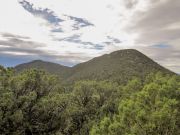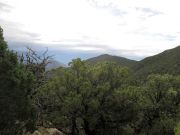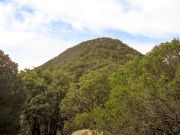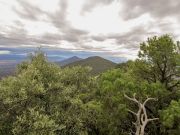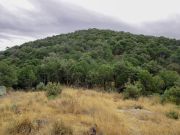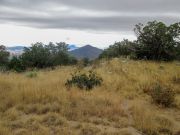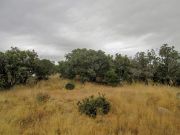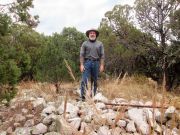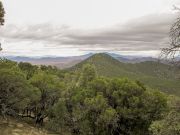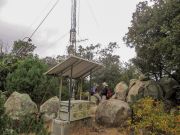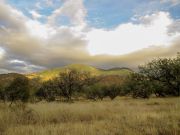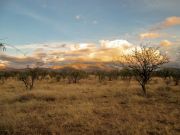
The Mountains of Arizona
• www.surgent.net
|
| Mount Washington & Veterans Peak |
• Highpoint: Patagonia Mountains • Coronado National Forest • Santa Cruz County |
|
Date: November 4, 2017
• Elevation: 7,221 feet
• Prominence: 1,709 feet
• Distance: 7 miles
• Time: 8 hours
• Gain: 2,700 feet
• Conditions: Mostly cloudy and cool
• Teammates: Scott Peavy & Matthias Stender
Veterans Peak: • Elevation: 7,211 feet • Prominence: 425-436 feet
Matthias, Scott and I teamed again to hike another peak, this time Mount Washington near the Mexican border east of Nogales. This peak don't get no respect. It's a range highpoint and highly prominent, but located in an area known for border crossers, both good and bad, not to mention a mine operation on one side that bars access from that side.
Little useful information exists on this peak. The HikeArizona site has some scant information on it, but not much. Summitpost had even less useful information (until I took over the page and fleshed it out). Not many people hike it for fun and leisure. It's likely that the majority of summitters are Mexican migrants and bandits who use the range to enter the United States. The summit lies just a mile and a half from the boundary.
The east side of the peak is home to a bunch of old mines, the main one being the Santo Nino Mine, which was active in about 1908. It begat the towns of Duquesne and Washington Camp, but when the mine played out, the towns became abandoned. Harshaw Road, which starts in Patagonia, goes by Duquesne, but the land is private and heavily posted against trespassing. Apparently a few people still live there.
Also, about ten years ago, some guy posted a whole bunch of strongly-worded warnings on Summitpost about all access to the peak being shut off, no one can go there, they have a zero tolerance policy, and so on. The guy gave an outfit in Tombstone that apparently bought or leased the properties but a web-search recently came up empty, and I wonder if that whole thing fell apart, too. I do not know the status of the Santo Nino Mines, other than the land is private. We weren't going to go that way anyway.
Our concern wasn't with meeting the landowner or miners or security guys. We were more naturally concerned about the Mexican border crossers. The ones coming over who just want to work in the fields don't concern us. The ones who work for the drug cartels and growers and transporters, those guys concerned us. But, we still wanted to explore the peak and the area. I hate being shooed away from ranges close to the border for fear of violence. It's a small gamble to be here, but one we were willing to consider. Maybe the hint of danger made it more exciting, I don't know.
We met at Matthias' place before dawn. He drove us through Tucson into Nogales, then through town to catch state route AZ-82, heading northeast. Soon, we got onto Kino Springs Road and followed it through a development. In a few miles, it met with Duquesne Road (Coronado Forest Road 61). Now dirt, we slowly scooted eastward into the mountains. The last couple miles of road were steep and narrow, hugging the hillsides, but in decent shape. The road crests the range at 5,960 feet. We parked in a pullout about 500 feet east of the crest. A Border Patrol guy drove by. The day was cool and cloudy, and we were moving by 8:30 a.m.
We walked back to the cattle grate and found what looked like a trail just east of the grate. We followed it into the hills and forest, and it went for a little while, gaining about 300 feet before it petered out. We continued up the steep forested slope, catching other trails in places. The undergrowth was not too heavy, so we were able to move freely through the trees. We came upon the top of Peak 7100, a gain of a little over a thousand feet in less than a mile. There were no views here and we did not stop. Angling right (southwest), we lost about 300 feet, then happened upon a very wide, nicely-tended trail.
We were aware through the HikeArizona and Summitpost pages of a guy who had single-handedly put in a trail to Veterans Peak and a little past it. We must have missed it on the first part, but here it was, wide and well defined. This allowed us to make good time on the next segment, the grunt up to Veterans Peak, about 1.5 miles from Peak 7100. Veterans Peak is just a few feet shorter than Mount Washington and on the way, located a mile north of Mount Washington. Bypassing it was not an option. We were going to tag a bonus peak whether we liked it or not.
The ridgewalk to Veterans Peak went well but was laborious, with ups and downs necessary to pass the many ridge-line bumps along the way. The final 400 vertical feet was up the trail, now steep with loose sections and one part that seems to have collapsed into a big sand slope. Soon, we were at (or near) the top of Veterans Peak. From a distance, we could see a small tower on the summit. Now, up close and in the thick trees, we couldn't see anything.
We angled left and walked through rock outcrops, tagging any apparent highest rocks. The trail was gone by now, the terrain here too rocky to allow a trail. We found abandoned encampments with water jugs and Mexican food wrappers, but no people. None of it looked recent. This segment, generally the 100 vertical feet below Veterans Peak summit, was tough. It was heavily forested with no views, and rocky to where hands needed to be used to scoot down small sections. More than once we had to turn around after getting cliffed out or into a brush thicket.
In time, we had descended far enough down to get past the worst of the rocks. We found the trail again, which dropped to the saddle between Mount Washington and Veterans Peak. We took a break at the saddle, the only cleared area of the whole hike. The day was still cool and mostly cloudy. Now and then the sun would poke through, but not for long. We took a break at this saddle.
Resuming the hike, we entered into the trees again, lost the trail and hiked by reckoning up the slopes to the summit. It took me a few moments to process that we were at the summit, and not just stopping again in the trees to rest. We arrived a few minutes past noon. The top itself is a small pile of rocks and an old pole on its side, but wooded. We dropped the packs and walked south a few yards to a bigger clearing, with views east, south and west. The clouds were low enough to hide Miller Peak, but south we could see Sierra San Antonio clearly, and the border running in the saddle below that peak and our position. We spent about 40 minutes up top, having a long break.
For the exit, we retraced our steps back to the saddle clearing, starting up the slopes to Veterans Peak. I think we all preferred to avoid going up and over that peak again. We found a good footpath that angled slightly east of the ridge, hoping that it might sidehill past Veterans Peak altogether. We hiked this segment for a few hundred yards, but it started to drop. It was clear it wasn't going where we wanted. The wise thing would have been to walk back from where we came, and resume the main route from there.
Instead, we just made a right-angle turn to our left and started bashing directly upslope, on slopes too loose and rubbly (and wooded) to be walked by mankind. It was an unenjoyable grunt, but it worked. After about fifteen minutes, we were at the high ridge and back to those pesky rock outcrops, but at least we were on route again.
Since we were essentially back to Veterans Peak, we decided to seek that tower, the one we somehow missed coming through a couple hours ago. Looking a little harder this time, we found it. It was just a few yards off our earlier route, but easily hidden by the trees. We walked to it, found a sign-in register, and sat around for a few minutes inspecting the area. We still agreed that the highest point of Veterans Peak is likely one of three or four big boulders about 50-100 yards to the south.
We found the trail again and started down the steep slopes, keeping to the trail until it was now at the base of Peak 7100. We then followed a better-looking trail down back to the road, but this trail seemed to bend too far west, and we were concerned this may be some migrant's path. So we angled more east through the brush and then downward, never finding any trail or path again. It worked, and we were back to the road, then shortly, back to Matthias' vehicle, the time 4:30, an eight-hour hike.
We drove down and took photos as the sun was setting. It was nearing darkness by the time we were back to the Interstate. Three hours later, we were back in Phoenix, another successful hike. As usual, we thanked one another for the experience.
This was a tougher hike than it would appear on paper or even looking at it from the start. The forest is very thick, and all three of us, at one time or another, bashed our heads into tree limbs. I did so twice, drawing blood once. We also got free bloody-arm scratches. It was slow going, but enjoyable. Not many people hike here, but the place has its own charms, although I certainly understand the skittishness people may feel about being where the border is so volatile.
|
|
